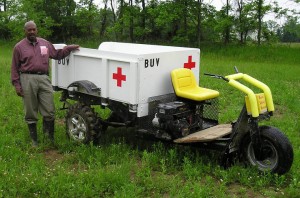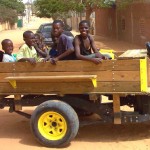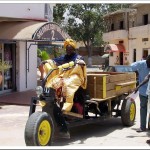It’s a little embarrassing. Cars go backward, tractors go backward, even motorized Rascals go backward.
For the last 15 years, the Basic Utility Vehicle (BUV) has not been able to go backward.
That could all change as we try to add a reverse gear to the BUV.
It’s not that we haven’t been able to add one in all this time, it’s that we have been trying to find the right one.
We have customers who actually like the fact that we don’t have reverse. People crash into things if they go backward. If you’ve never driven before, driving backward is a problem. From the standpoint of reducing accidents, this has been a big help to people who are learning to drive.
Another issue is durability.
Small transmissions with the appropriate gear ratios that are robust enough aren’t made here in the U.S. anymore. Thirty years ago, there were tons to choose from. Nowadays, the reverse-equipped transmissions are made in India and China, and we’re hard-pressed to find one that will withstand the rigors of Africa.
When it comes to Africa, we need transmissions that are extra tough and extra forgiving. It’s very hard to service a vehicle anyway, which is why we use the fewest number of moving parts possible, and use extra durable parts (like pickup truck brakes, rather than car or motorcycle brakes).
But having a gear system where a driver can shift gears opens up the possibilities for damage. Right now, the BUV uses a speed reducer gearbox, which gives the vehicle a lot of torque, but the driver doesn’t shift anything, which greatly reduces the possibility of damage.
We’re testing a robust reverse gear
Despite the lack of availability of the right kind of transmission, we’re still testing and working to find the right kind of reverse gear. And we may be close.
We’re getting ready to install a gearbox on a new unit, which we’ll take to the testing grounds near Zionsville, IN, as well as run it in this year’s BUV competition.
Next, we’ll hire a team of teenage boys to drive it and see if they can break it. The plan is to overload the test vehicle and have them drive it in a field of moguls, and see if they can break the gearbox.
If they break it, it’s back to the drawing board. If they don’t, then we can start installing the new gearbox on the vehicles in 2016.
The power of neutral
We’re also considering other possibilities the new gearbox brings, such as a neutral gear.
Not going anywhere can actually be beneficial, because the BUV can be used as a PTO (power take-off) source.
A PTO is a way to take power from a source, such as an engine, and use it to run an attached machine or implement, like a grain mill, corn sheller, thresher, or water pump. This changes the BUV from “just” a transportation vehicle, to a multi-purpose tool that can do several jobs.
We’ll keep you posted on the test results, and how we fare in our quest to go backward.


